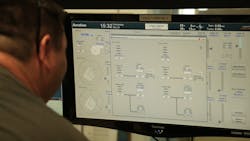Sustainable SCADA for Water Districts
Kent Melville is a sales engineer for Inductive Automation. Melville can be reached at [email protected]. Jim Meyers is success manager for Inductive Automation. Meyers can be reached at [email protected].
undefinedMany traditional systems for supervisory control and data acquisition (SCADA) are not actually sustainable. They may rely too heavily on proprietary hardware and software. They may have licensing fees that hinder expanding the system. Maintenance requirements may be too costly and time-consuming.
Creating a sustainable SCADA system is not as hard as one might think. With the right approach, it can be done in phases and will lead to improvements that provide better service to customers. A modern SCADA system provides data and processes that help with some of the biggest challenges facing utilities, such as financial constraints, regulatory demands and aging infrastructure.
Starting small is a good first step, and allows practical changes that will update a system without causing shutdowns or downtime. From there, it is about gradually creating a future-proof SCADA system that will work today, tomorrow and years down the line. Here are 10 steps to follow. Even adopting just a couple can reap benefits.
1. Programmable Logic Controllers
Most systems includes hardware from multiple manufacturers that communicate in several different protocols. Unfortunately, maintaining support and connectivity to a wide variety of devices and protocols is not always sustainable. This does not mean old equipment must be replaced, but rather that adding new equipment on an open protocol—such as Modbus, OPC, or MQTT—can be useful. This simple step takes some confusion out of programmable logic controller (PLC) operation and moves toward a unified system.
2. Remote Devices
After adopting a standard protocol, data collection should be more streamlined. This means better access to remote sites. With an offsite PLC connected over radio or a cellular network, polling will be limited by bandwidth and latency. If a loss in a connection to that device occurs, this also means a loss of data. An easy solution is to have a device installed at the remote site that polls the device locally and reports only by exception. This means data only is sent up to the central location when there is a change. If the network goes down, the edge device can buffer the data and forward it when the connection is restored.
3. Server-Centric Architecture
A sustainable SCADA system should be server-centric because it requires minimal software installation, rather than the maintenance of many installs on multiple machines. A server-centric architecture requires that the software only be installed centrally. Because all data collection and visualization goes through that server, it is a single point of failure. Redundancy is key to maintaining up-time in the event of server failure.
A true server-centric system saves money, as it is licensed by the server, and would not include additional fees for adding new clients, tags, devices, users or projects.
“On one of our previous systems, we had a failure which resulted in an 18-hour outage of SCADA,” said Jason Hamlin, plant instrumentation technician for a water district in the eastern U.S. “Our operators had to run everything manually while we were trying to restore the backups. When we moved to Ignition, we also moved to a virtualized environment with separate sets of physical hosts. We very rarely have any type of downtime. When we test it, I’m able to do full backup recoveries in minutes, so coming from 18 hours to minutes is a huge thing for me.”
4. Web-Launched Clients
Web-launched clients are a crucial part of a server-centric architecture. Rather than traditional client screens that are individually developed, exported and installed on each client machine, there is no install process required with web-launched clients. Updates automatically are pushed out, eliminating the need to repeat the process over and over. This functionality increases scalability and allows for quick rollout of project updates.
“The web-launched client is one of my favorite features of Ignition,” said Henry Palechek, information and process control supervisor for a water district in California. “In the past, I would have to purchase a license for each client computer. Now I don’t have to do that. And the clients are virtually zero-administration systems. There’s no SCADA software to install, there’s nothing to patch or keep up to date. The web-launched clients have greatly reduced the amount of work needed to maintain my SCADA system overall.”
5. Cross-Platform
Traditionally, SCADA systems have been tied to a specific version of Microsoft Windows, which creates problems as versions reach end-of-life and people are forced to upgrade their SCADA systems along with their operating systems. These changes can be costly. By using a cross-platform SCADA system, the server and SCADA client can run on any version of Windows, Linux or Mac.
“We set up our primary server running with Windows and a backup server running Linux, not just because of the licensing fee savings, but because it’s a security best practice,” Hamlin said. “There’s a limited footprint for zero-day attacks because we’re actually running on two separate platforms.”
6. Templates/UDTs
Templates and user defined types (UDTs) are an easy way to save large amounts of time while building SCADA projects. It is unsustainable to define each tag individually and recreate a similar visualization every time someone is configuring a screen. To be sustainable, SCADA should implement an object-oriented approach, so data types can be defined once and used throughout the project. For example, when building out a system with motors, an object-oriented approach would create a UDT with all of those shared tags. Passing in the motor number to create additional motors is all that would need to be done. This makes it easy for a team to scale out a project without requiring additional support for screen creation.
“Templates and UDTs are very helpful,” Hamlin said. “The quickness of my development time in Ignition, I can’t really compare it to before. Every system should have this, because it just makes everything much faster and easier. It’s the only way I’ve been able to keep my system running as a team of one person.”
7. Remote Alarms & Notifications
Part of a sustainable approach is taking care of the current equipment. When something goes wrong, a quick response is the best response. In a perfect world, this would mean someone staring at SCADA screens constantly to make sure the system is running smoothly. Since that usually is not possible, remote alarm notifications are a crucial addition to a sustainable SCADA system. A system that allows for an email, text, or phone call to be sent directly to operators can be a lifesaver.
8. Automatic Reporting
In an unsustainable system, reporting requires high levels of labor and attention. Automated reporting results in less labor. This especially is true if a facility has someone walking around the plant floor recording statistics at regular intervals. Not only are the opportunities for human error greater in this scenario, but in a larger facility reporting easily could turn into a full-time job. Automated reporting improves accuracy, and also saves time and resources.
“The reporting in the new Ignition system will probably save us close to eight man-hours per week,” said Alain Richard, operations manager for a water agency in Texas. “With the old way, the operator would enter the data on a paper spreadsheet. Then we’d have to go in and enter the information on a computer. Then a program from another computer would grab the data off of it and create the report. Now, we just click on the report page and the data is entered right there. No more paper. We’re eliminating all the paper and the double-checks and triple-checks on the information. With the improvements, the agency is able to report to the state much faster than before.”
9. IIoT & MQTT
While industrial internet of things (IIoT) is certainly a buzz-phrase these days, there are real, practical applications of IIoT in water and wastewater, since there usually are lots of remote sites connected over radio, satellite or cellular connections. IIoT is about getting full access to as much data as possible.
This can efficiently be done with MQTT—a publish and subscribe protocol that allows edge-of-network devices to publish data to a broker. The broker can forward messages to any clients that have subscribed, providing just the information that each subscriber wants. It is an efficient way to communicate, particularly because MQTT uses
little bandwidth.
10. Capital Expenditure vs. Operational Expenditure
How does all this affect the bottom line? Building out a sustainable SCADA system can save money with unlimited tags and devices, as well as faster development and deployment of screens. It also can eliminate downtime with cross-platform capabilities and redundancy, and can allow software upgrades at any time because the client is not tied to a specific operating system. With all these advantages, a case can be made to include a SCADA system into the operational budget rather than capital expenditures.
“We deployed our system in-house,” Palechek said. “We didn’t use any capital funding. In fact, we haven’t used any capital funding since deploying Ignition. It’s freed up our resources to help me address the issues of my aging infrastructure, control my SCADA costs, and create a sustainable SCADA solution.”





